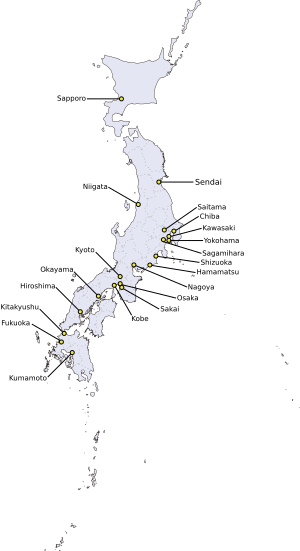Cities designated by government ordinance of Japan facts for kids
A designated city (in Japanese, seirei shitei toshi) is a special type of city in Japan. To become one, a city needs to have more than 500,000 people. The Japanese government, specifically the Cabinet of Japan, gives these cities their special status under a law called the Local Autonomy Law.
These designated cities get to handle many tasks that are usually managed by the larger prefectural governments. This includes things like public schools, helping people in need (social welfare), keeping the city clean (sanitation), giving out business licenses, and planning how the city grows. While the city government handles the everyday tasks, the prefectural government still makes the bigger decisions. For example, a designated city can give licenses to small clinics, but bigger hospitals need a license from the prefectural government.
Designated cities also have to divide themselves into smaller areas called wards (ku in Japanese). These wards are a bit like the boroughs you might find in big cities like London or New York. Each ward has its own office that helps with city services. They handle things like registering residents (koseki and juminhyo) and collecting taxes. In some cities, these ward offices even help with business licenses or building permits. The city itself decides how these wards are set up and what powers they have.
It's important to know that the 23 special wards of Tokyo are different. Tokyo is actually a prefecture, and its wards act more like independent cities. Even though some Tokyo wards, like Setagaya and Nerima, have enough people to be designated cities, they aren't considered "cities" under this special law, so they don't get the designated city status.
Once a city becomes a designated city, it has never lost that status.
Contents
What is a Designated City?
In Japan, a designated city is a large city that has been given extra powers by the national government. This means they can manage more of their own affairs instead of relying on the larger prefectural government.
Special Powers of These Cities
Designated cities have more control over their local services. They can manage:
- Education: Running local schools and educational programs.
- Social Welfare: Providing support and services for citizens in need.
- Sanitation: Managing waste collection and public health.
- Business Licensing: Approving licenses for many local businesses.
- Urban Planning: Deciding how the city develops and grows.
How Wards Work
Every designated city is split into smaller areas called wards. Think of them as neighborhoods with their own mini-government offices. These ward offices make it easier for people to access city services close to where they live. They help with things like:
- Registering new residents.
- Collecting local taxes.
- Handling permits for small businesses or construction.
Tokyo's Special Wards
Tokyo is unique. It's not just a city; it's also a prefecture. The areas often thought of as "Tokyo City" are actually 23 separate special wards. These wards act almost like independent cities themselves. They are not part of the designated city system we're talking about here.
List of Designated Cities
Here are the cities in Japan that have been designated by the government. These cities have been special since 1956.
| Name | Japanese | Skyline | Flag | Emblem | Area (km2) | Population | Population density | Date of designation | Region | Prefecture | No. of wards | Lists of wards | Map |
|---|---|---|---|---|---|---|---|---|---|---|---|---|---|
| Chiba | 千葉市 | 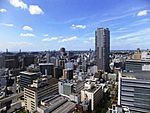 |
271.77 | 972,861 | 3,613 | 1992-04-01 | Kantō | Chiba | 6 | List | |||
| Fukuoka | 福岡市 | 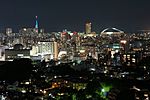 |
343.39 | 1,579,450 | 4,668 | 1972-04-01 | Kyushu | Fukuoka | 7 | List | |||
| Hamamatsu | 浜松市 | 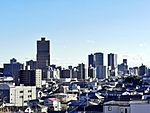 |
1,558.06 | 795,350 | 506 | 2007-04-01 | Chūbu | Shizuoka | 7 | List | |||
| Hiroshima | 広島市 | 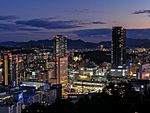 |
906.68 | 1,194,524 | 1,321 | 1980-04-01 | Chūgoku | Hiroshima | 8 | List | |||
| Kawasaki | 川崎市 |  |
143.01 | 1,503,690 | 10,765 | 1972-04-01 | Kantō | Kanagawa | 7 | List | |||
| Kitakyushu | 北九州市 | 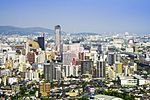 |
491.95 | 945,595 | 1,901 | 1963-04-01 | Kyushu | Fukuoka | 7 | List | |||
| Kobe | 神戸市 |  |
557.02 | 1,526,639 | 2,719 | 1956-09-01 | Kansai | Hyōgo | 9 | List | |||
| Kumamoto | 熊本市 |  |
390.32 | 737,812 | 1,892 | 2012-04-01 | Kyushu | Kumamoto | 5 | List | |||
| Kyoto | 京都市 | 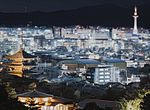 |
827.83 | 1,468,980 | 1,758 | 1956-09-01 | Kansai | Kyoto | 11 | List | |||
| Nagoya | 名古屋市 | 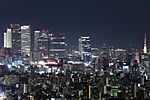 |
326.45 | 2,283,289 | 7,128 | 1956-09-01 | Chūbu | Aichi | 16 | List | |||
| Niigata | 新潟市 | 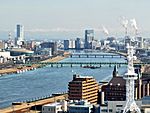 |
726.45 | 807,450 | 1,089 | 2007-04-01 | Chūbu | Niigata | 8 | List | |||
| Okayama | 岡山市 | 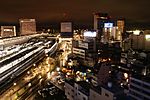 |
789.95 | 720,841 | 912 | 2009-04-01 | Chūgoku | Okayama | 4 | List | |||
| Osaka | 大阪市 |  |
225.21 | 2,727,255 | 12,226 | 1956-09-01 | Kansai | Osaka | 24 | List | |||
| Sagamihara | 相模原市 | 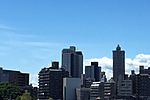 |
328.91 | 720,986 | 2,198 | 2010-04-01 | Kantō | Kanagawa | 3 | List | |||
| Saitama | さいたま市 | 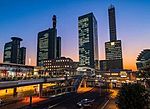 |
217.43 | 1,226,656 | 6,072 | 2003-04-01 | Kantō | Saitama | 10 | List | |||
| Sakai | 堺市 | 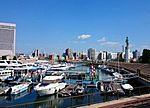 |
149.82 | 833,544 | 5,500 | 2006-04-01 | Kansai | Osaka | 7 | List | |||
| Sapporo | 札幌市 | 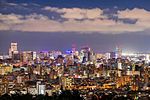 |
1,121.26 | 1,955,115 | 1,750 | 1972-04-01 | Hokkaido | Hokkaido | 10 | List | |||
| Sendai | 仙台市 | 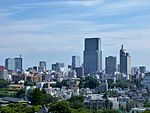 |
786.30 | 1,088,669 | 1,389 | 1989-04-01 | Tōhoku | Miyagi | 5 | List | |||
| Shizuoka | 静岡市 | 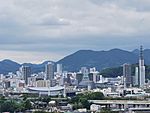 |
1,411.90 | 697,578 | 486 | 2005-04-01 | Chūbu | Shizuoka | 3 | List | |||
| Yokohama | 横浜市 | 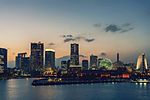 |
437.56 | 3,732,616 | 8,588 | 1956-09-01 | Kantō | Kanagawa | 18 | List |
How a City Becomes Designated
For a city to become a designated city, it must meet certain requirements:
- It needs to have a population of more than 500,000 people.
- Both the city's local assembly and the prefectural assembly must agree to the designation.
- The city then applies to the national government.
Cities That Could Be Designated
Some cities in Japan already have populations over 500,000 but haven't yet been designated. Here are a few examples:
| Name | Japanese | Flag | Emblem | Area (km2) | Population (2012) | Region | Prefecture | Map |
|---|---|---|---|---|---|---|---|---|
| Funabashi | 船橋市 | 85.62 | 610,492 | Kantō | Chiba | |||
| Hachiōji | 八王子市 | 186.38 | 579,799 | Kantō | Tokyo | |||
| Himeji | 姫路市 | 534.43 | 536,218 | Kansai | Hyōgo | |||
| Kagoshima | 鹿児島市 | 547.58 | 607,257 | Kyushu | Kagoshima | |||
| Kawaguchi | 川口市 | 61.95 | 561,788 | Kantō | Saitama | |||
| Matsuyama | 松山市 | 429.40 | 516,823 | Shikoku | Ehime | |||
| Utsunomiya | 宇都宮市 | 416.85 | 513,722 | Kantō | Tochigi |
A Look Back: History of Designated Cities
The idea of special cities in Japan started way back in 1878. Back then, every city had "wards," but the biggest cities like Tokyo, Osaka, and Kyoto had many wards.
Later, in 1889, city assemblies were created, but Tokyo, Osaka, and Kyoto still had their ward assemblies. By 1898, these three big cities were allowed to form their own city assemblies. More cities like Nagoya (1908), Yokohama (1927), and Kobe (1931) also adopted the ward system before World War II.
After the war, in 1947, a new law called the Local Autonomy Law was passed. The five cities that were already divided into wards (Tokyo had become a prefecture by then) were called "special cities." This "special city" system was then changed to the "designated city" system in 1956.
For a while, the government wanted designated cities to be expected to reach a population of one million people soon. But in 2005, this rule was changed. This made it easier for some large cities, especially those that had grown bigger by merging with nearby towns, to become designated cities.
Images for kids
See also
 In Spanish: Ciudades japonesas designadas por decreto gubernamental para niños
In Spanish: Ciudades japonesas designadas por decreto gubernamental para niños


